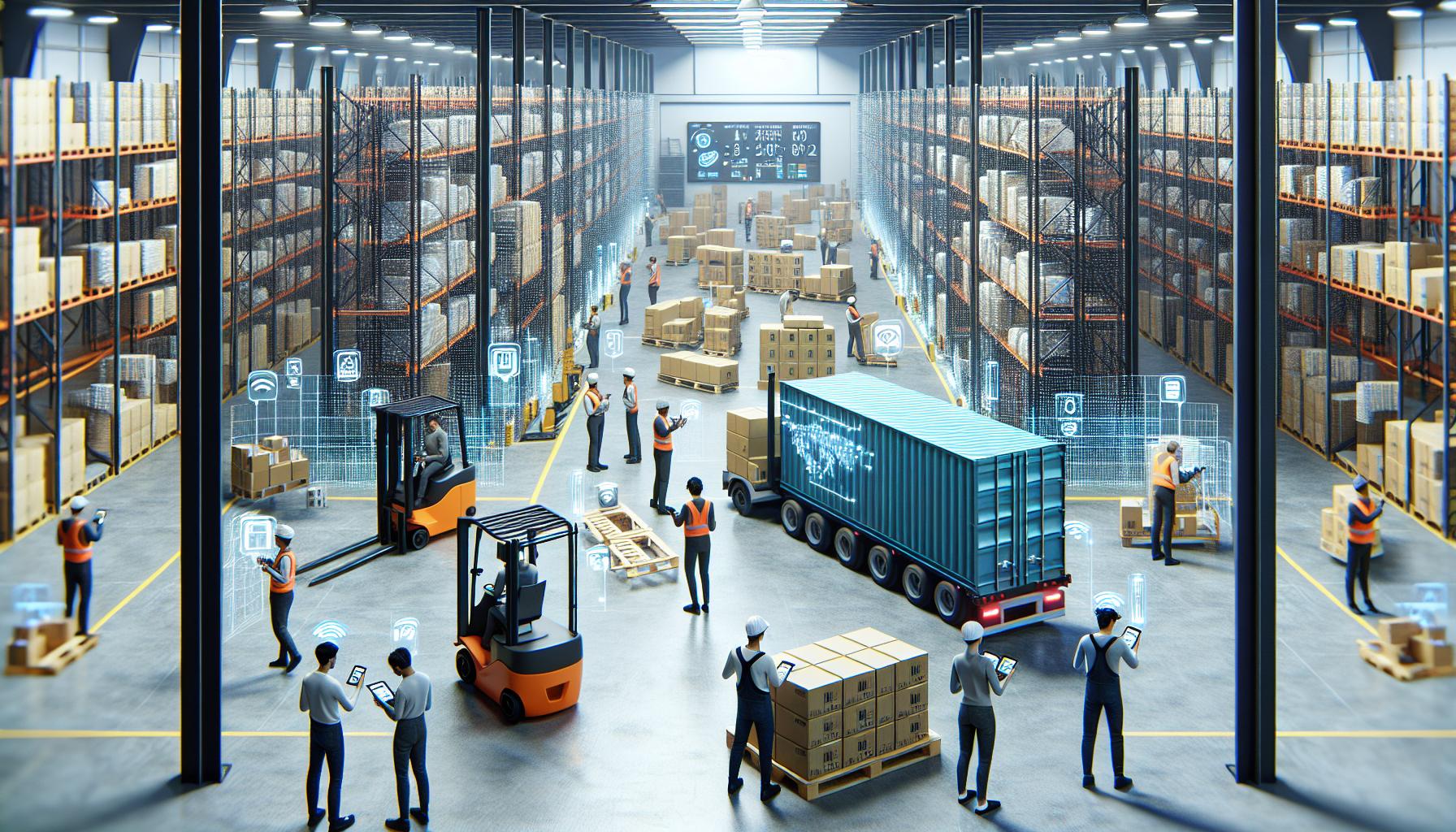In a world where everything seems to be getting smarter, the supply chain is no exception. Imagine a warehouse where your packages are not just sitting around but chatting with each other—yes, you heard that right! Thanks to the Internet of Things (IoT), everyday items can now communicate, track, and optimize their journey from point A to point B.
Picture this: a fleet of delivery trucks equipped with sensors that can tell you when they’re running low on fuel or if they’ve hit a pothole that could throw off your delivery schedule. It’s like having a personal assistant for your shipments, minus the coffee runs. This article dives into a prime example of IoT in the supply chain, showcasing how technology is revolutionizing logistics and making life a whole lot easier—one smart package at a time.
What Is An Example of IoT in The Supply Chain?
IoT technology plays a crucial role in enhancing supply chain operations. This technology connects devices through the internet, allowing them to share data in real time. Sensors placed on packages enable communication between items, providing insights such as location and condition during transit.
A notable example involves smart pallets that monitor temperature and humidity. These pallets assist in transporting sensitive goods like pharmaceuticals and food, ensuring compliance with safety standards. By tracking environmental conditions, companies can prevent spoilage and maintain product integrity.
Delivery trucks also benefit from IoT applications. Truck-mounted sensors monitor fuel levels, engine performance, and tire pressure. Real-time updates improve maintenance schedules, reducing downtime and enhancing efficiency.
Data analytics from IoT devices aids in supply chain decision-making. Companies can analyze patterns in shipping times, costs, and delivery routes. Improved forecasting from this data allows for more reliable inventory management, minimizing overstock and stockouts.
Security enhances through IoT technologies as well. GPS tracking systems safeguard shipments by alerting companies about potential theft or tampering. This real-time monitoring fosters a safer transit environment for valuable goods.
Integrating IoT into the supply chain encourages automation. Automated systems, equipped with IoT data, optimize logistics processes, reducing human error. Robotics in warehouses streamline sorting and packing operations, ensuring faster turnaround times.
IoT technologies revolutionize the supply chain by improving efficiency, safety, and decision-making. The continuous flow of information supports a streamlined logistics experience, transforming how goods move from manufacturers to consumers.
Real-World Examples

Real-world applications of IoT in the supply chain demonstrate significant improvements in efficiency and effectiveness. Various companies across industries are embracing these technologies to optimize their operations.
Smart Inventory Management
Smart inventory management systems utilize RFID tags and sensors to track product levels in real-time. These systems automatically notify stakeholders when stock is low, enabling timely reorders. Accurate data on inventory reduces overstock and stockouts. Certain retailers, like Walmart, implemented such technologies, resulting in streamlined operations and reduced carrying costs. Smart shelves equipped with weight sensors detect when items are sold and communicate this to inventory management systems. By analyzing this data, businesses can better predict future demand, further enhancing operational efficiency.
Predictive Maintenance
Predictive maintenance leverages IoT sensors to monitor equipment health across operations. These sensors provide real-time data on machine performance, allowing companies to forecast potential failures before they happen. For instance, shipping companies deploy sensors on delivery trucks to monitor engine conditions and other critical systems. When abnormalities arise, alerts are sent to maintenance teams, prompting proactive repairs. This strategy reduces downtime and maintenance costs significantly. Companies employing predictive maintenance report fewer unexpected breakdowns, enhancing overall reliability and customer satisfaction.
Benefits of IoT in the Supply Chain

IoT technology provides several advantages that significantly enhance supply chain operations. By connecting various devices, it facilitates real-time communication and data sharing.
Increased Efficiency
Incorporating IoT into supply chains leads to streamlined operations. Smart sensors on shipping containers and pallets allow for precise tracking of goods, reducing delays. Organizations can automate inventory management systems using RFID tags, ensuring stock levels are optimal. With real-time data analysis, companies can quickly adjust their processes to accommodate demand fluctuations. Predictive maintenance becomes possible with IoT devices, enabling firms to address equipment issues before they escalate. This proactive approach minimizes downtime and boosts overall workforce productivity.
Enhanced Visibility
IoT solutions provide unparalleled visibility across the supply chain. Tracking shipments in real-time allows stakeholders to monitor progress from origin to destination. GPS-enabled devices enhance security by providing updates on shipment locations. Companies can respond swiftly to disruptions, identifying issues and implementing solutions immediately. Additionally, transparency in conditions during transit, such as temperature and humidity tracking, provides reassurance for sensitive products. Enhanced visibility fosters trust among partners, ensuring smoother collaborations throughout the entire supply network.
Challenges and Considerations

Implementing IoT in the supply chain presents several challenges. Organizations must navigate data security concerns and integration with existing systems effectively.
Data Security Concerns
Data security remains a critical challenge for IoT in supply chains. Sensitive information transmitted between devices can be vulnerable to breaches. Companies must employ robust encryption methods to safeguard data during transmission. Regular software updates are essential to address potential vulnerabilities in IoT devices. Monitoring system access helps detect unauthorized users and reduces risks. Establishing security protocols ensures compliance with regulations and builds trust among stakeholders. Failure to mitigate these concerns can lead to financial losses and damage to reputation.
Integration with Existing Systems
Integration poses another significant challenge. Many organizations operate on legacy systems that may not easily connect with modern IoT solutions. Conducting a thorough assessment of current technologies provides insight into compatibility and necessary upgrades. Collaborating with IT experts ensures a seamless integration process while minimizing disruptions. Training staff on new technologies fosters acceptance and utilization of IoT advancements. Addressing integration challenges enables companies to maximize the benefits of IoT without overhauling entire systems, enhancing operational efficiency overall.
Future Trends in IoT and Supply Chain
Emerging technologies in IoT promise to reshape the supply chain landscape. Companies are increasingly utilizing artificial intelligence alongside IoT devices to enhance data analysis. Combining these technologies allows for better prediction of demand trends, enabling proactive inventory management.
Integration of blockchain technology also plays a pivotal role. Blockchain enhances IoT by providing secure and transparent transaction records, making it easier to trace product origins. This transparency builds consumer trust, particularly for industries like food and pharmaceuticals that require stringent safety standards.
Automated drones and delivery robots represent a significant trend. These innovations streamline last-mile logistics, reducing shipping times and costs. As these technologies evolve, reliance on human intervention diminishes, creating efficiencies in delivery and distribution.
Augmented reality (AR) is gaining traction in warehouse management. AR applications assist workers in locating items quickly and efficiently, minimizing delays. The combination of AR and IoT leads to a seamless environment where employees can access real-time data while performing tasks.
Sustainability becomes increasingly crucial in supply chains influenced by IoT. Smart sensors can monitor energy consumption and waste levels in real time, prompting companies to adopt greener practices. Tracking carbon footprints through connected devices enables organizations to meet corporate social responsibility goals.
Finally, edge computing is revolutionizing how data is processed in the supply chain. Moving data processing closer to IoT devices reduces latency and enhances response times. This shift empowers companies to react swiftly to changing market conditions, further optimizing operational efficiency.
The integration of IoT in the supply chain is reshaping logistics and operations across various industries. By enabling real-time communication and data sharing among devices, companies can enhance efficiency and decision-making. Smart sensors and analytics not only improve tracking and inventory management but also foster transparency and trust among partners.
As organizations continue to adopt these technologies, they must also address challenges like data security and system integration. Embracing IoT solutions will ultimately lead to a more responsive and agile supply chain, paving the way for future innovations that can further streamline operations and enhance customer satisfaction.



